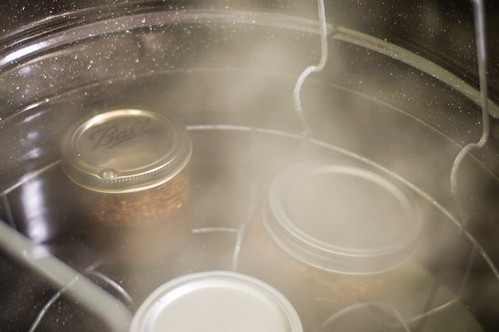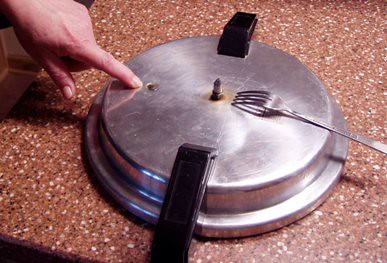 Well, I certainly opened up the floodgates for folks with the ‘my grandmother told me about the time she just left the kitchen ‘for a moment’ and her pressure canner exploded and cousin CindyLou got burned and the windows blew out and she never used a pressure canner ever again’ stories.
Well, I certainly opened up the floodgates for folks with the ‘my grandmother told me about the time she just left the kitchen ‘for a moment’ and her pressure canner exploded and cousin CindyLou got burned and the windows blew out and she never used a pressure canner ever again’ stories.
The business end of these tales usually involve the fact that it’s someone’s grandmother – who was canning in 1925, using the dial canner technology of the time…was not watching the damn canner (and did not ‘leave for a moment’ – but actually went outside to yell at one of the other kids – and had to chase the dog out of the garden and then decided to pick some corn for supper and so on)…and Cousin CindyLou got burned – because she opened the top or took the weight off the vent tube before things were cold inside. As for the windows blowing out – well, Aunt Toby suspects that there is a little bit of dramatic license being taken there to justify the fact that they never used the pressure canner again.
I think there is also this tremendous number of people out there who would like to can but who are terrified that they will blow up the house. Folks – it ain’t 1925.
Here we have a photograph (courtesy of my on-the-spot camera guy) where I am showing two of the three major safety systems in modern (post 1980) pressure canners.  The handy fork is pointing toward the vent. That’s what you put the weight on and the steam coming out of that causes the weight to jiggle. My finger is pointing to the overpressure valve. If somehow the vent got plugged and too much pressure built up inside the canner, there is a button that would pop up, like one of those temperature gauges that’s installed in some turkeys – only on the pressure canner, it would release the extra steam. The third part of the safety system, which you can’t see in this photograph is a spring-loaded safety pin that is under one of the handles – this pushes on the rubber gasket that goes inside the lid and prevents the canner from becoming pressurized unless the top is completely sealed and locked down.
The handy fork is pointing toward the vent. That’s what you put the weight on and the steam coming out of that causes the weight to jiggle. My finger is pointing to the overpressure valve. If somehow the vent got plugged and too much pressure built up inside the canner, there is a button that would pop up, like one of those temperature gauges that’s installed in some turkeys – only on the pressure canner, it would release the extra steam. The third part of the safety system, which you can’t see in this photograph is a spring-loaded safety pin that is under one of the handles – this pushes on the rubber gasket that goes inside the lid and prevents the canner from becoming pressurized unless the top is completely sealed and locked down.
Here are a couple of hard facts that just might help you over some of your fear –
1) Pressure canner design and technology went through a complete change in the 1970s and 1980s. Any pressure canner made since that time is safe as long as it is operated according to instructions. And if you remember a couple of things, you should have no safety issues whatsoever:
a. First – don’t over fill the thing. In general, whatever capacity the canner says it has in terms of numbers of quart jars or pint jars, that is all you can get in there. As a matter of fact, in terms of pint jars because you’d be putting them on top of one another, I’d put in one jar less.
b. Secondly – do a safety check before you put anything into it. Hold the lid up to a light( your kitchen window, a lamp) and look out through the vent from underneath the lid. You should see clear through. If you can’t, then wash the lid and put a pipe cleaner or a piece of wire up through the vent and run it back and forth until it is completely clean. Plugged vents are a major contributor to pressure issues with pressure canners. pressure canner safety systems
c. Third – Do you know how old your pressure canner is? Is this a legacy from YOUR grandmother? Is it something you picked up at a garage or estate sale? Do you know if it was ever dropped (aluminum can sustain hidden damage and that could end up with catastrophic results). Although I am sure that someplace on this earth, there is someone who collects old pressure canners or even pressure canner dials, It is definitely NOT worth the safety issues if you do not know when the thing was made. On the other hand, even if it was built after 1980 and was used with tender loving care, it still might need to have the gasket or other safety parts replaced. If it’s too much of a bargain to resist, look on the bottom or elsewhere on the canner, find the manufacturer and model number and call/email/write the manufacturer to find out how old it is and how safe it is to use. If the manufacturer no longer exists – well, you can always plant flowers in it. Here is a great resource to identify Mirro pressure canners. Identifying a canner
d. Once you put the jars into the canner and close it…hang around for a while. Listen while the canner vents the air (it makes a real ‘shhhhhh’ shound) and arrange to do things in the kitchen. Don’t figure you can wander around the house, clean the bathroom, check on this or that. You are canning. You don’t have to watch the canner every second, but stay in the room.
More resources on canning and canners:
Used Canners
Uni. GA, using pressure canners
Canning 101
Creative Blog on Canning – this story is about the exploding pressure canner
Another Canning Blog
Now, Aunt Toby was wracking her brains after she posted about canning because for the life of me, I could not recall why exactly we chose the model of canner that we did. We did not get one of those with a dial. And then I read this, courtesy of Miss Vickie: “Most problems with pressure canners is a gauge that is not working properly or needs to be calibrated. If the gauge is out of calibration, it will need to be replaced, or in some cases it may be sent back to the manufacturer for re-calibration. Check with your manufacturer to see if they offer this service and the cost. Even newer canners should be tested to ensure the safety of the food being processed. Dial gauges should be tested annually or more often if used frequently.
Your local Cooperative Extension may perform this test for you or provide information on how to get this done. In some cases the manufacturer may be able to test their various models, or even cookers made be other manufacturers. Contact manufacturers directly and inquire if testing services are available and be prepared to pay a modest fee for this service, as well as shipping costs both ways. Often, especially in the case of large, old-fashioned canners, the costs of shipping out weigh the actual value of the vessel.” Testing Dial Canners
THAT’S WHY – I figured that anything that required that sort of maintenance, testing, calibration, and whoopdeedoo was not worth having if I could get something that just jiggled, never needed to be tested and could be maintained by checking the vent and replacing the gasket on a regular basis.
The other thing is this – let’s say for the sake of argument that you don’t know beans about canning. Nothing. At all. Even with what I’m saying here (and I am trying my best to be as encouraging as I possibly can be because I think canning stuff is a great way to have great food available to you especially during emergencies), I am going to recommend something: Call your county Cooperative Extension and ask if they have classes in canning. If they don’t – ask them to consider putting one together, even if it means that you have to gather up your friends, coworkers and your mother in law to fill up the class. This is a life skill that really pays off. You never know – your extension might even have a commercial type kitchen with really big time canning equipment so that you don’t have to go out and buy your own (though it’s great to have your own canner – trust me on that). Here is a link that will get you to a place where you can find any extension office anywhere in the US of A. How to Find Your Closest Cooperative Extension Office
OK..everyone feeling a little bit better about the whole pressure canning business now? Remember, your grandmother’s story about the exploding pressure canner … was just a story..that’s right…just a story…..
(Photo at the top courtesy of bookgrl)

Never canned. But I used to love pressure cooking. Never had any explosions or problems. Unfortunately the pressure cooker went with the girlfriend when we broke up. Making me think I should buy a new one. I tend to be impatient about food: I forget about it, then suddenly I want to eat. Which means I rarely eat soups, stews and whatnot, which is a pity because I love them. But with a pressure cooker you can have such foods far far sooner.
Ian – our pressure canner, as far as I’m concerned was the best investment we ever made.